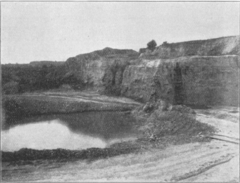The Patapsco Formation is a geologic formation of varigated clays, sandy clays, and sand in Virginia, the District of Columbia, Maryland, Delaware, Pennsylvania, and in the subsurface of New Jersey.[1][2] It preserves fossils such as plants and molluscs dating back to the Cretaceous period.[1]
| Patapsco Formation | |
|---|---|
| Stratigraphic range: | |
 Outcrop of the Patapsco Formation at Reynold's Mine, Anne Arundel County, Maryland showing the Arundel Formation overlain by the Patapsco Formation | |
| Type | Formation |
| Unit of | Potomac Group |
| Underlies | Raritan Formation |
| Overlies | Arundel Formation |
| Thickness | 200 feet (60 m) |
| Lithology | |
| Primary | clay, sand |
| Other | silt |
| Location | |
| Region | |
| Country | |
| Type section | |
| Named for | Patapsco River |
| Named by | William Bullock Clark (1897)[1] |
See also
editReferences
edit- ^ a b c Clark, W.B. (1897). Outline of present knowledge of the physical features of Maryland (Report). Volume Series. Vol. 1. Maryland Geological Survey. pp. 172–188.
- ^ Richards, Horace G.; Olmstead, F. H.; Ruhle, James L. (1962). "Generalized structure contour maps of the New Jersey coastal plain" (PDF). New Jersey Geological Survey Reports. 4: 38. Retrieved 28 June 2018.
- Various Contributors to the Paleobiology Database. "Fossilworks: Gateway to the Paleobiology Database". Retrieved 17 December 2021.